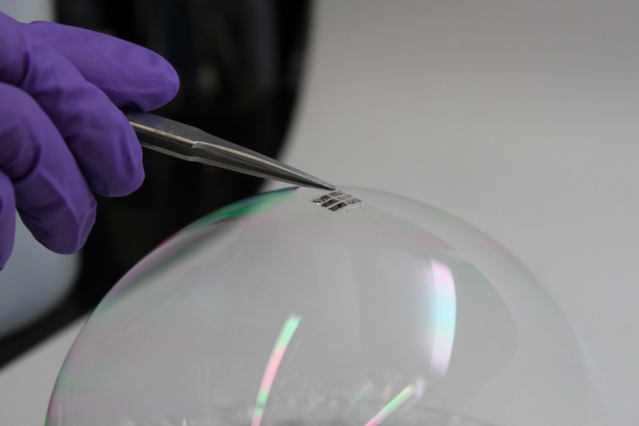MIT engineers created the lightest solar cells

MIT engineers have developed a process for creating ultrathin and lightweight solar cells based on polymers. Panels convert light into electricity in the same way as their more familiar counterparts, but in terms of the ratio of energy produced to weight, they are hundreds of times greater than them. To demonstrate their ease, scientists placed a small fragment of a panel on a soap bubble.
The leading expert of the study, Professor Vladimir Bulovich [Vladimir Bulović], explained that the polymer used in the laboratory to make flexible solar panels in the laboratory was vaporized and organic matter DBP was used. Vaporite serves as both a substrate and a protective coating. But these materials were chosen only as an example - the main innovation was the method of growing panels.
')
The new technology allows you to grow the entire panel entirely - along with the substrate, the filling and the protective coating. This eliminates the need for careful handling of parts of the panel, in particular, with the prevention of dust between its layers. For this purpose, a special film is applied to the glass substrate on which the solar panel is grown. At the end of the process, the panel is removed using a film.
“We place the film in a vacuum, then put the rest of the components on it, and then remove everything at once,” explains Annie Wang, one of the authors of the paper.

Layers of parylene with a thickness of only 2 microns make the resulting panels very thin, flexible and light. They can be applied to virtually any surface, from fabrics, mobile devices and various things to balloons. The properties of new solar panels are especially valuable in areas such as aviation or aeronautics - the new panels have one of the highest ratios of energy produced to weight.
Standard glass-based panels can produce 15 watts per kilogram, and new panels that have not even reached their maximum in power generation - 6 watts per gram. This is 400 times more. Of course, for now this is a laboratory sample, proof of the efficiency of the technology - but the prospects for its use are quite broad.
Source: https://habr.com/ru/post/391111/
All Articles